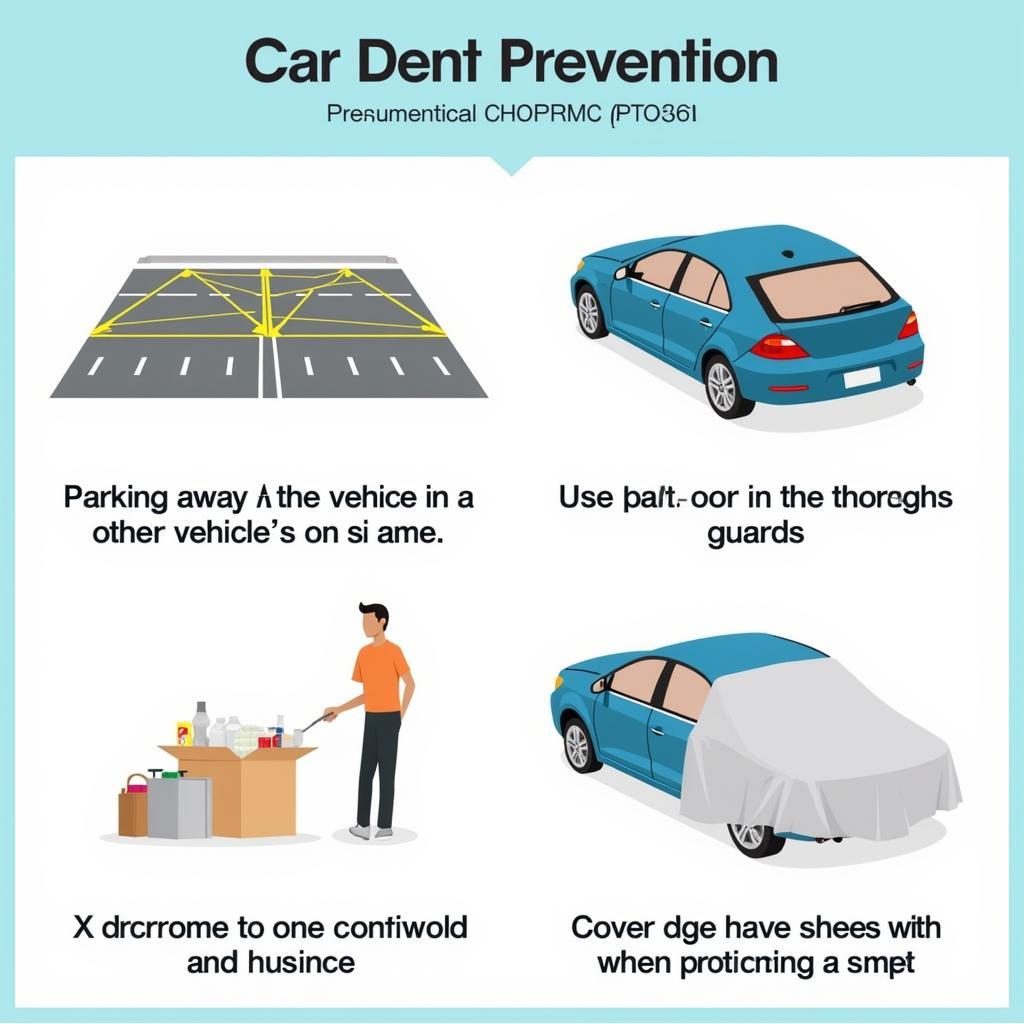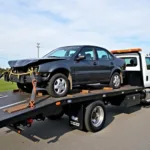Fixing a car dent can be a daunting task, but with the right knowledge and tools, you can often repair minor dents yourself. This guide will provide a step-by-step approach to repairing car body dents, covering various methods from DIY fixes to professional repairs. We’ll also discuss when it’s best to leave it to the experts.
Learning how to repair a car body dent not only saves you money but also gives you a sense of accomplishment. We’ll explore different techniques, helping you choose the best approach for your specific situation. Whether it’s a small door ding or a more significant crease, understanding the repair process is essential.
If you’re unsure about tackling more complex car repairs, you might find our guide on how to repair car bumper clips helpful. It provides valuable insights into another common car body issue.
Assessing the Dent: Know Your Enemy
Before you start, you need to assess the damage. Is the dent shallow or deep? Is the paint cracked or chipped? The severity of the dent will determine the best repair method. Small, shallow dents without paint damage are often repairable with DIY methods. Deeper dents, especially those with paint damage, may require professional intervention.
Types of Dents
- Minor Dents: These are shallow depressions in the car body without paint damage.
- Crease Dents: These are sharper, more defined dents, often with a visible line or fold in the metal.
- Complex Dents: These involve significant damage, often with metal deformation and paint chipping.
DIY Dent Repair Methods: The Home Mechanic’s Toolkit
Several DIY methods can effectively address minor dents. These include:
- The Plunger Method: This classic technique involves using a suction cup plunger to pull the dent outwards. It’s best suited for shallow dents on flat surfaces.
- Hot Glue and Pulling: This method involves gluing pulling tabs to the dent and then using a slide hammer or similar tool to pull the dent out.
- Hair Dryer and Compressed Air: This technique uses heat from a hair dryer to expand the metal, followed by a burst of compressed air to pop the dent outwards. This method is most effective on plastic bumpers.
- Boiling Water: Similar to the hair dryer method, pouring boiling water over the dent can sometimes cause the plastic to expand and return to its original shape.
 DIY Dent Repair Tools – Plunger, Glue, Slide Hammer
DIY Dent Repair Tools – Plunger, Glue, Slide Hammer
Knowing who repairs cars can also be helpful in deciding whether to tackle the repair yourself or seek professional help. Our guide on “who repairs cars” provides a comprehensive overview of the different types of automotive repair professionals.
Professional Dent Repair: When to Call the Experts
While DIY methods can be effective for minor dents, more significant damage often requires professional repair. Professionals have specialized tools and expertise to handle complex dents and paint damage. They can use techniques like paintless dent repair (PDR) to restore your car’s body to its pre-accident condition.
Paintless Dent Repair (PDR): The Art of Metal Manipulation
PDR is a specialized technique that uses specialized tools to massage the dent out from behind the panel. This method preserves the original paint finish and is often quicker and less expensive than traditional bodywork.
If you are concerned about the cost of other car repairs, such as AC repair, you might find our article on “how much price it will take to repair car ac” useful. It provides insights into the factors affecting AC repair costs.
Preventing Dents: Protecting Your Investment
Preventing dents is always better than repairing them. Here are some tips to protect your car from dents:
- Park in safe areas away from high-traffic zones.
- Be mindful of opening doors in tight spaces.
- Use protective coverings when transporting items that could potentially dent your car.
 Car Dent Prevention Tips – Parking Safely and Protecting Car Surface
Car Dent Prevention Tips – Parking Safely and Protecting Car Surface
Knowing how to repair crack car glass is another valuable skill for car owners. Our guide provides a step-by-step approach to repairing minor cracks in your windshield.
Conclusion: Reclaiming Your Car’s Pristine Appearance
Repairing a car body dent can range from a simple DIY fix to a more complex professional repair. By understanding the different methods available, you can choose the best approach for your specific situation. Whether you opt for a DIY fix or professional intervention, addressing dents promptly helps maintain your car’s appearance and value. Remember to assess the damage carefully and choose the method that best suits your skills and the severity of the dent.
FAQ
- Can I repair a dent with a hairdryer? Yes, for minor dents, especially on plastic bumpers. However, it’s crucial to be cautious and avoid overheating the paint.
- Is PDR suitable for all types of dents? No, PDR is most effective for shallow dents without paint damage.
- How much does professional dent repair cost? The cost varies depending on the severity of the dent and the repair method.
- Can I use a plunger to fix any dent? No, plungers are best suited for shallow dents on flat surfaces.
- How can I prevent dents in the future? Park carefully, be mindful of opening doors, and consider protective coverings.
- What if my dent has chipped paint? Chipped paint usually requires professional repair to prevent rust and further damage.
- How do I choose the right DIY method? The type of dent and the materials you have available will determine the most suitable DIY method.
Learning about how to repair car jack area can also be helpful for maintaining your car.
For further assistance, contact us via WhatsApp: +1(641)206-8880 or Email: [email protected]. Our customer service team is available 24/7.


